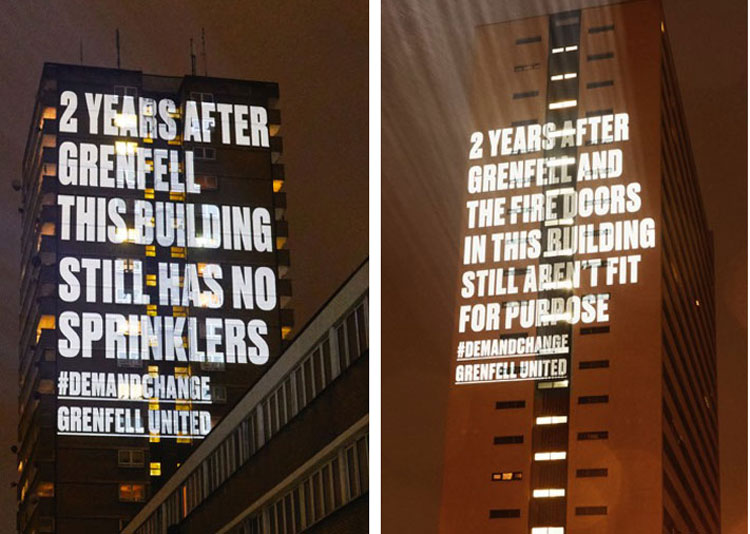LONDON — A Silent Walk and other events June 14 were joined by thousands, marking the second anniversary of the Grenfell Tower fire here that killed 72 people. The deadly inferno was the result of the contempt of government officials and the building’s managers and owners towards its working-class residents. The 24-story tower was wrapped in highly flammable cladding, which went up in a fast-spreading fire, in a building with broken fire alarms and no sprinkler system.
Fourteen of the families who survived the blaze still haven’t been rehoused.
Actions were held across the country. In London, Newcastle and Salford large lighted messages were projected across the walls of tower blocks by Grenfell United. “2 years after Grenfell and the fire doors in this building still aren’t fit for purpose,” read the message projected on the 25-story Cruddas Park House in Newcastle.
“I heard how the residents were raising concerns but being ignored,” Karim Mussilhy, vice-chair of Grenfell United, told the media when he visited Cruddas Park. “That’s what happened to residents in Grenfell before the fire.”
Natasha Elcock, chair of Grenfell United, said: “It’s been two years, and people are still going to bed at night worried that a fire like Grenfell could happen to them.”
Days earlier a fire ripped through an apartment block in Barking, in east London — a stark reminder of the devastating consequences for working people of the substandard safety measures tens of thousands still face. In this case wooden frames and balconies and faulty sprinklers and fire alarms were at fault. Luckily this time no one was killed.
The London Fire Brigade’s union says that just 32 out of 837 council tower buildings over 30 meters tall (98 feet) have sprinklers. The BBC reports that Grenfell-type cladding remains on high rise council properties in 62 places across England. The government has admitted that cladding had been removed from just 56 of the 158 social sector buildings, and 13 out of 146 private high-rises.
A 20-story block adjacent to the burned-out remains of Grenfell Tower still has no sprinklers.
Last month the government announced a £200 ($250) million fund to remove combustible cladding from the private towers — but it only covers buildings with aluminum composite material, and not the other forms of flammable cladding used to coat some 1,700 additional buildings.
More pressure needed
“Many people are still living in dangerous buildings” not covered by the removal fund, the Manchester Cladiators group told Architects’ Journal, “and facing the bills for correction, life-changing bills of up to £80k each.”
Under the pressure of the outcry and protests after the Grenfell disaster, the government set up an inquiry into the fire, the first phase of which concluded at the end of 2018. A second phase is set to begin next year. No report has been published. The Metropolitan Police have announced that they will not consider whether to lodge any criminal charges before 2021.
“Have you got anything about Grenfell Tower?” Shaun France asked members of the Communist League when he visited their busy literature stand at the Grenada Heritage Day festival in London July 6.
“Workers don’t need the fraud of long inquiries and ‘better’ regulations or ‘feel your pain’ visits by party leaders and the Royals,” says a widely circulated statement the CL issued days after the fire. France got a copy. “We should join with the survivors of Grenfell Tower in their fight for immediate quality re-housing in the local area and serious compensation. The trade unions should engage in a mass campaign — working together with tenants around the country demanding the immediate dismantling of cladding, installation of sprinklers and other protective measures nationwide.”
“Money-saving trumps safety under capitalism,” Communist League member Jonathan Silberman said. “Workers and our unions must fight for workers control over construction and building work to prevent further Grenfell Towers.”


